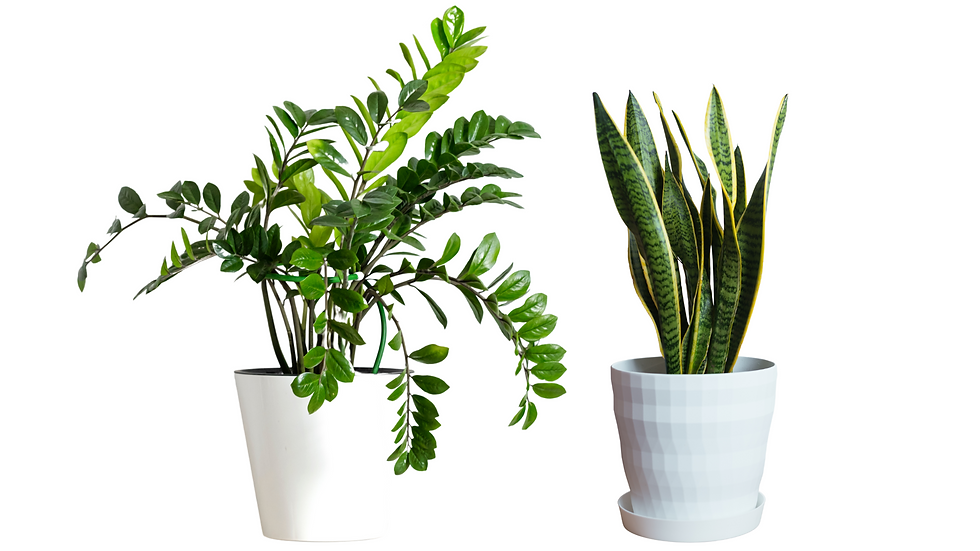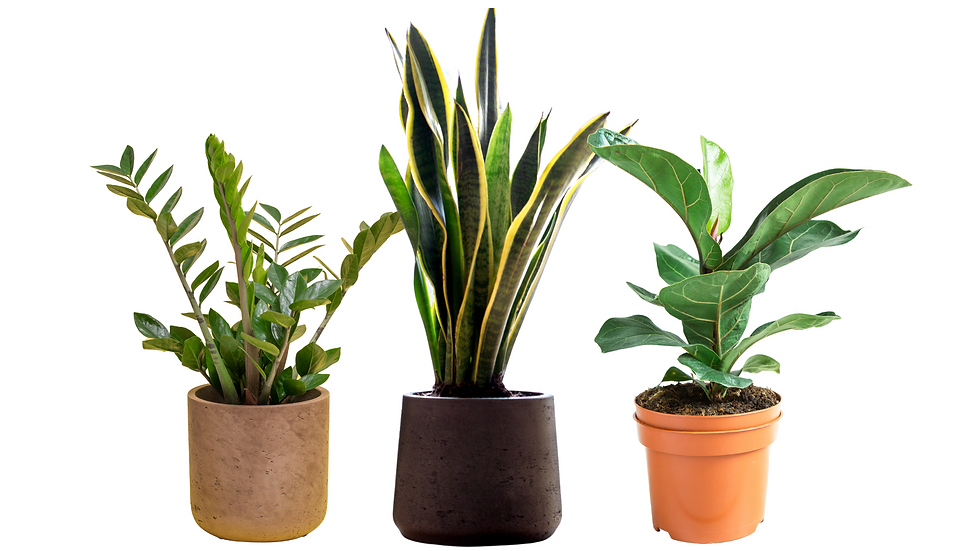Surviving and Thriving: Expert Tips for Plant Care from a Real-Life Greenhouse Expert
- Plantcare.club

- Mar 1
- 7 min read
Whether you’re a seasoned plant parent or a fresh-faced newbie, we're here to make sure your indoor jungle stays lush and vibrant. As greenhouse plant experts, we’ve gathered our top tips and tricks for making sure your plants not only survive but thrive.
Ready to unleash your inner plant guru? Let's do it...
1. Understanding Light Levels: Let the Sun Shine on You!
Light is everything for plants. It’s their food, their energy source, their happy place. But not all plants want the same amount of light. Some are sun worshippers, while others are happy chilling in the shade. Here’s how to get it right:
Low Light Lovers 🌑:
These plants are perfect for darker corners, offices, or rooms with only a hint of sunlight.
Snake Plant (Sansevieria): If there’s a plant that can survive a power outage, it's the Snake Plant. Known for its “can-do” attitude, this low-maintenance superstar can thrive in low light (or even no light). Plus, it’s a champion at purifying air. You might notice that it grows taller when it’s not getting enough light, but no worries—it's still doing fine.
Care Tip: Keep your Snake Plant in a spot with indirect light. Overwatering is its #1 enemy, so let the soil dry out before watering again.
ZZ Plant (Zamioculcas zamiifolia): The ZZ plant thrives in the dimmest of spaces and will still look chic and lush. It's practically indestructible, so even if you forget about it for a few weeks, it’ll forgive you. This plant is perfect for beginner plant parents who aren’t quite sure how often to water.
Care Tip: While the ZZ plant is low-maintenance, make sure its pot has drainage. Allow the soil to dry out completely between waterings, and it will keep looking fresh.

Bright Light Lovers ☀️:
These plants like to bask in the sun and show off their vibrant beauty. If you’ve got a sunny window, these are the perfect candidates for that spot!
Ageratum Butterfly Plant: This one’s a showstopper, with beautiful blue or purple blooms that attract pollinators. It thrives in bright, indirect light but can also handle a little direct sunlight if needed. Just make sure the soil is well-draining.
Care Tip: These plants love the warmth, so don’t be afraid to move them into a sun-soaked area. Just make sure the soil is moist but not soggy. If you see a slowdown in growth, move it to a brighter spot!
Spider Plant (Chlorophytum comosum): Spider Plants are often called the "easy-care rockstars." Their green and white striped leaves look stunning in any light, though they truly shine in bright, indirect light. Bonus: they’re natural air purifiers! You’ll get baby plant "spiderettes" hanging down, which you can propagate into new plants.
Care Tip: If your Spider Plant looks a bit leggy, it’s telling you it wants more light. Move it closer to the window, and you’ll see it perk right up.

2. Watering 101: Don’t Drown (or Starve) Your Plants! 💦
Watering can make or break your plants, and trust us, they’re picky. Some plants love a good soak, while others prefer to stay dry.
Here's how to find that perfect balance:
Signs You’re Overwatering 🚫:
Yellowing leaves.
Soggy, smelly soil.
Root rot (hello, mushy roots).
Solution: Let the soil dry out between waterings, and make sure your pot has drainage holes to prevent water from sitting at the bottom. Snake Plants, for example, like to dry out between drinks.
Signs You’re Underwatering 🌵:
Crispy, brown edges.
Dry, cracked soil.
Wilting leaves.
Solution: If your plant has gone too long without water, give it a good soak. Water thoroughly until the water runs out of the drainage holes. Then, stick to a regular watering schedule so they don’t get thirsty again!

Watering Frequency 💧:
Ficus Trees: These beauties like their soil to dry out slightly between waterings. Let the top 2 inches dry before giving it a drink.
Dumb Cane (Dieffenbachia): These tropical plants like consistent moisture but hate sitting in water. Check the soil regularly and water when the top 1-2 inches feel dry.
Tip: A simple “finger test” is all you need! Stick your finger into the soil—if it’s dry an inch or two down, it’s time to water.
3. Humidity & Temperature: Creating the Perfect Cozy Atmosphere
Plants don’t just need light and water—they also need the right temperature and humidity to thrive. Plants from tropical regions like it warm and humid, while others prefer a drier, cooler environment.
Here’s how to make your home feel like a plant paradise:
Humidity Heroes:
Tropical plants, like the Mini Monstera (Rhaphidophora tetrasperma) and Alocasia Poly, need humidity to keep their leaves healthy. Without it, they might start to get crispy edges or brown tips. Here’s how to keep your humid-loving plants happy:
Solution: Grouping plants together increases humidity, or you can place a humidity tray filled with water and pebbles under your plants. You can even mist them lightly if your home is particularly dry (but don’t overdo it!).
Temperature Control:
Most indoor plants like a consistent temperature between 60-75°F (15–24°C). Avoid placing them near drafts, heaters, or air conditioners where they might experience sudden temperature swings.
Tip: If you live in a colder climate, don’t let your plants sit near windows in the winter where cold air can shock them. Try moving them to a warmer, more stable spot.

4. Fertilizing: Plant NEED food
Plants, like people, need food to grow strong and healthy. Fertilizing gives them the extra nutrients they need, especially during their growing season. But just like us, they don’t need food all the time—moderation is key.
Why Fertilize?
Fertilizer provides essential nutrients (like nitrogen, phosphorus, and potassium) that help plants grow and thrive, especially in nutrient-poor soil.
Types of Fertilizer:
Water-Soluble Fertilizers: Great for easy feeding—just dilute in water and feed your plants directly.
Slow-Release Fertilizers: Perfect for those who forget to fertilize regularly. These release nutrients slowly over time.
Signs of Over-Fertilization 🚨:
Yellow leaves.
Burnt leaf edges.
Stunted growth.
Solution: If you’ve gone overboard, flush the soil with water to wash away excess fertilizer. Going forward, cut back on fertilizer applications.
Care Tip: During the growing season (spring and summer), feed your plants once a month. In fall and winter, most plants go dormant, so reduce or stop fertilizing.

5. Repotting: A Bigger Pot for Bigger Plants 🌱
As your plants grow, they need more space to stretch their roots. If you’ve had your plant for a while and it’s starting to look crowded in its pot, it’s time to repot!
When to Repot:
Roots growing through drainage holes.
Roots circling the inside of the pot.
Stunted growth or leaning plants.
Care Tip: Repot in the spring or early summer when your plants are actively growing. Choose a pot 1-2 inches larger in diameter than the current one.

6. Low-Maintenance Plants That Survive (and Flourish) with Minimal Effort 🌿
Not everyone has the time (or patience) for high-maintenance plants. Luckily, these low-maintenance options are perfect for plant beginners or busy plant parents:
ZZ Plant: Tough, resilient, and nearly indestructible, the ZZ plant thrives on neglect. It’s perfect for beginners and can survive in low light with minimal watering.
Snake Plant: The Snake Plant is like the superhero of the plant world. It can survive in almost any light, and it only needs water once every few weeks. It’s an easy-to-care-for, air-purifying gem.
Ficus Bambino: This compact Ficus thrives in bright, indirect light and needs little watering. It’s perfect for apartments and smaller spaces.

7. Troubleshooting Common Plant Problems
Even the best plant parents run into problems. But don’t panic—here’s how to solve some common plant dilemmas:
Yellow Leaves:
Usually a sign of overwatering or poor drainage.
Solution: Let your plant dry out before watering again and check that its pot has good drainage.
Leggy Plants:
Your plant is probably trying to reach for more light.
Solution: Move it closer to the window or add a grow light to provide the extra light it needs.
Brown Leaf Tips:
Often caused by low humidity or underwatering.
Solution: Increase humidity around your plants, or water them more regularly.
More Plant Care Tips?
By following these easy-to-understand tips, you’ll be a plant care pro in no time! Whether you’re tending to a tough ZZ plant or a tropical beauty, creating the perfect environment for your plants to thrive is all about a little love, the right light, and the occasional water break.
At Plantcare.club, we’re here to help you every step of the way. Got questions or need more tips? Join our community of plant lovers, and let’s keep our indoor jungles growing!
If you have questions about caring for your plants or want to learn more about their unique journeys, don’t hesitate to reach out to us at plantcare.club.
Listen to our latest podcast episodes 👇
We're here to support your plant parent journey with tips, resources, and a community of fellow plant lovers!
Download our plant care guides at plantcare.club for helptips tips!







Comments